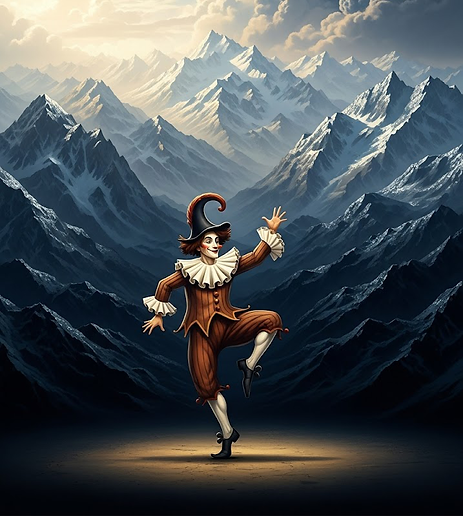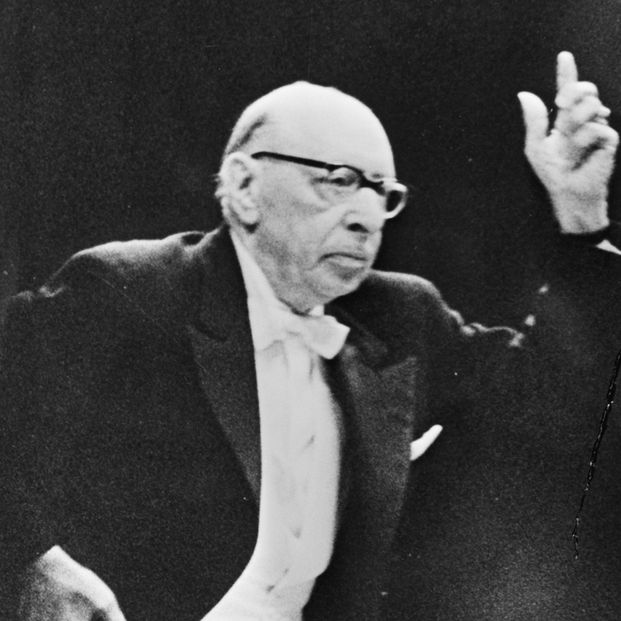
The Great and the Graceful
Saturday 18 October, 7.30pm
Pulcinella Suite - Igor Stravinsky
-- INTERVAL --
Symphony no. 9 in C - Franz Schubert
Jon Malaxetxebarria – Conductor


Pulcinella Suite
Igor Stravinsky (1882-1971)
1. Sinfonia
2. Serenata
3. Scherzino - Allegretto - Andantino
4. Tarantella
5. Toccata
6. Gavotta (with two variations)
7. Vivo
8. Minuette - Finale
Few works mark a turning point in a composer’s career as clearly as Pulcinella did for Igor Stravinsky. After the bold modernism and rhythmic fire of The Firebird, Petrushka, and The Rite of Spring, this 1920 ballet announced a striking change of direction — a turn towards elegance, balance, and wit. This new approach, later called neoclassicism, would shape much of Stravinsky’s music for decades to come.
Pulcinella was commissioned by Sergei Diaghilev for his Ballets Russes, with choreography by Léonide Massine and designs by Pablo Picasso. Diaghilev suggested that Stravinsky base the score on music attributed to the 18th-century composer Giovanni Battista Pergolesi — though it was later discovered that much of it was actually written by Domenico Gallo. Stravinsky’s treatment of these Baroque sources was far from simple arrangement: he preserved their graceful melodies and forms but reimagined them with piquant harmonies, rhythmic surprises, and a distinctly modern sense of humour. The result was both affectionate and ironic — a witty conversation between centuries.
The Pulcinella Suite (1922) condenses the ballet into eight concise movements for small orchestra, with a string quintet (two violins, viola, cello, and double bass) acting as a concertante group throughout. The Sinfonia opens with radiant clarity, the quintet and winds exchanging crisp, elegant phrases. The Serenata follows with a tender melody sung by solo cello, while the Scherzino offers playful dialogue between flute and bassoon. The Allegretto features charming duets for violin and double bass, their lyrical lines lightly underpinned by the strings. The Andantino brings a moment of expressive calm, led by oboe and violin solos that evoke a gentle, pastoral dance.
In sharp contrast, the Tarantella bursts forth with dazzling rhythmic energy, its quicksilver passages showcasing the agility of the strings. The Toccata follows with dazzling interplay between winds, brass, and strings, particularly the trumpet solo, before giving way to the Gavotta, scored uniquely for wind and brass instruments only — a moment of bright, clear-toned contrast.
The seventh movement, Vivo, provides a witty interlude: here, the trombone and double bass step into the spotlight for a cheeky, virtuosic exchange — full of swagger, slides, and comic exaggeration. Finally, the Finale unites the whole ensemble in a jubilant conclusion, where Baroque poise and Stravinskian brilliance combine in sparkling style.
In Pulcinella, Stravinsky found a new artistic voice — one that looked to the past for inspiration, but spoke unmistakably in the language of the 20th century. Its freshness, clarity, and playful invention continue to charm and surprise audiences a century later.

Symphony no. 9 in C
Franz Schubert (1797-1828)
1. Andante - Allegro ma non troppo - Piu moto
2. Andante con moto
3. Scherzo - Trio
4. Finale: Allegro vivace
Franz Schubert’s Ninth Symphony stands as one of the grandest achievements of the early Romantic era — a work that bridges the classical world of Beethoven and the expansive, emotional landscapes of later composers like Bruckner and Mahler. Completed around 1826 but not performed publicly until more than a decade after Schubert’s death, the symphony has since become a cornerstone of the orchestral repertoire.
Its popular nickname, “The Great C major,” helps to distinguish it from Schubert’s earlier Sixth Symphony, also in C major. But the word “great” means more than just “larger” — it captures the music’s remarkable breadth, energy, and visionary scope. Robert Schumann, who helped champion the work in 1839, described it as possessing “heavenly length,” admiring its sheer vitality and imagination.
The opening movement begins mysteriously, with a distant horn call that seems to awaken the orchestra from slumber. What follows is a majestic sonata-form structure full of rhythmic drive and lyrical invention. Schubert’s gift for melody is everywhere — themes unfold with songlike beauty, yet the symphonic argument is powerful and purposeful. The relentless triplet rhythms that underpin much of the movement give it a sense of forward momentum, while moments of repose remind us of Schubert’s deep lyricism and humanity.
The Andante con moto that follows is at once contemplative and restless. It begins with a gentle, almost pastoral tread in the strings, over which wind instruments sing a plaintive melody. As the movement unfolds, the calm surface is repeatedly disturbed by stormier outbursts and sudden harmonic twists, suggesting an emotional journey beneath its outward serenity. This interplay of light and shadow — of tranquility and tension — gives the movement a haunting, deeply human character.
By contrast, the Scherzo erupts with exuberant energy. Its bounding rhythms and syncopated accents evoke a sense of joy and physical vitality, perhaps echoing the folk dances of Schubert’s native Vienna. The contrasting Trio section provides lyrical relief, its broad, flowing lines offering a glimpse of tenderness before the dance rhythms return with renewed force.
The Finale drives forward with unstoppable energy, propelled by rapid string figures and bold brass interjections. It is a tour de force of rhythmic invention and symphonic mastery — jubilant, grand, and full of life. The signature moments – bringing back the recapitulation in E flat major rather than C major; the driven repeated chords in the coda – add real individuality into this whirlwind of a movement. In this radiant conclusion, Schubert seems to celebrate the sheer exhilaration of creation itself, bringing “The Great C major” to a triumphant close.

Jon Malaxetxebarria
Conductor
Born in Gernika in the Basque Country (Spain), Jon has conducted numerous ensembles, demonstrating his versatility in symphonic and operatic repertoires that range from baroque to contemporary music. He has worked with orchestras such as the Orquesta Radio Televisión Española, Basque Country Symphony Orchestra, Bilbao Symphony Orchestra, Navarra Symphony Orchestra, Oviedo Filarmonía, Orquesta Sinfónica de Extremadura, Manchester Camerata, Liverpool Mozart Orchestra, Crosby Symphony Orchestra, Sheffield Philharmonic Orchestra, and the Malaga Philharmonic, among others.
Jon is currently the Musical Director of the Hallam Sinfonia, and has previously held this position with the Basque Student Orchestra (EIO) and the Solihull Symphony Orchestra.
A committed advocate for contemporary music, Jon has premiered numerous works, including Simon Dobson’s Trombone Concerto with Peter Moore and the RNCM Brass Band, broadcast on BBC Radio 2. He conducted the world premiere of the Basque opera Saturraran in collaboration with the Arriaga Theatre in Bilbao and has led the Bilbao Symphony Orchestra at the Musikaste Contemporary Music Festival.
In the realm of opera, Jon has conducted productions of J.C. Arriaga’s works at the Arriaga Theatre and served as Assistant Conductor at the Liceu (Barcelona) and Teatro Real (Madrid) in productions including Bellini’s Il Pirata and La Sonnambula, Verdi’s Luisa Miller, Honegger’s Jeanne d’Arc au bûcher, and Donizetti’s Maria Stuarda, alongside maestros such as Maurizio Benini and Juanjo Mena.
Jon is professor of Conducting Studies at Musikene in San Sebastián and has taught conducting at Junior RNCM and Leeds Conservatoire.
Following his studies in French horn at Roosevelt University in Chicago with Dale Clevenger, Jon moved to Manchester in 2010 to study orchestral conducting at the Royal Northern College of Music. Upon graduation, he received the Mortimer-Furber Prize in Conducting.
Hallam Sinfonia
Violin 1
Hannah Thompson-Smith, Katy Silverman, John Cummins, Anton Nikolaev, Richard Gilbert, Paul Adam, Lucy Pickard, Richard Allen, John Cooper, Amanda Johnson
Violin 2
Kate Fehler, Hannah Watson, Mary Dougherty, Catherine Bowman, Helena Vassiliadis, Deborah Blewitt, Rachael Evans, Holly Chambers, Lasse Rempe
Viola
Charlotte Kenyon, Helen Mather, Kiri Smith, Sue Adam, Laura French
Cello
Nat Blakesley, Benjamin Jackson, Jeremy Dawson, Dominic Smith, Joy Paul, Sue Dumpleton, Matthew Moore, Angela Rosenfeld
Bass
Tom Davies, Stuart Wilson, John Goepel, Paddy Appelqvist, Christie Harrison
Flute/Piccolo
Judith Ennis, Kathryn Hathaway
Oboe
Helen Jenkinson, Carolyn Bean
Clarinet
Karen Burland, Cath Murray
Bassoon
Dawn Allenby, Liz Versi
Horn
Rachel Melland, Mick Nagle
Trumpet
Matthew Redfearn, George Breakwell
Trombone
Andrew Knowles, Nick Hart, Richard Dixon
Timpani
Adam Harrod







